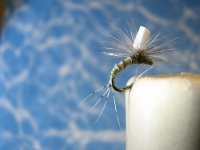BelAirSteve
Member
- Joined
- Sep 9, 2009
- Messages
- 680
As I have said in my other posts, I am still very new to tying, but I am having a blast. I am reading a lot, and tying a lot. My home water is the Gunpowder, and the midge fishing is pretty good there in the winter. I have seen articles and videos on biot bodies for dry flies, but I wonder if anyone ties midges with biots for the natural segmentation effect.




